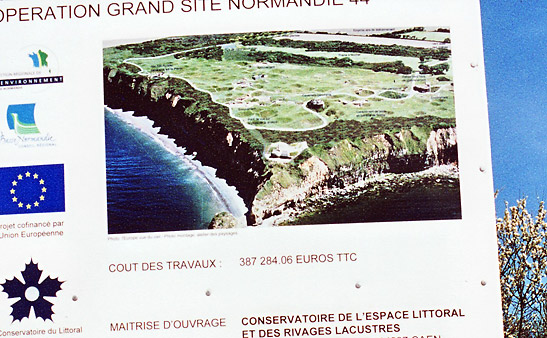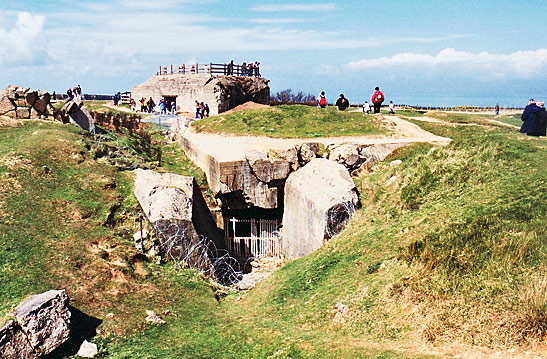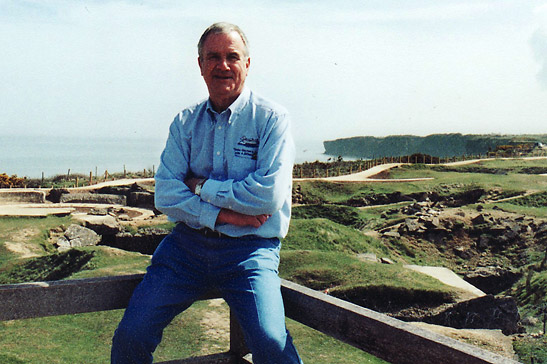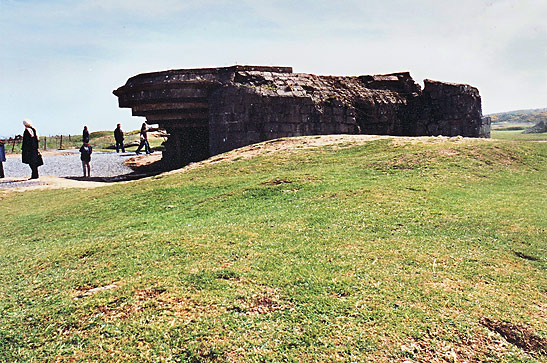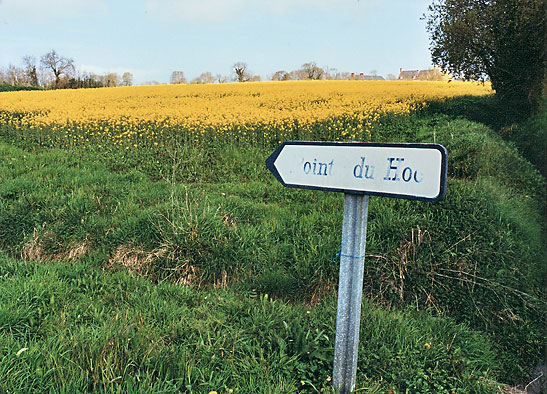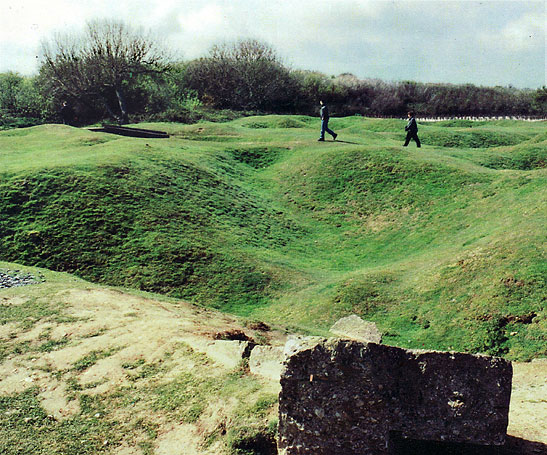|
The Moonscape of Normandy’s
Pointe Du Hoc Story and Photos by John Clayton
Even now I hear some of you saying “Is he nuts or what? I mean what about all those marvelous artistic treasures in all those superb French museums, what about them. Are they not to be included?” Again, that’s true, but in the coming months I’ll share with you MY thoughts and VERY personal observations on military related things around the world – but especially in Europe – that are about people, places and other war events that I found to be extraordinary. But here’s the BIG difference. These are NOT features about events or people today but, as the series title indicates, “Memorabilia,” which means from yesterday – that is in the past, and more often than not, in the far and distant past. Which is why I hope you’ll become a regular reader of these blogs. In addition, they are NOT what you might expect from a blog about a military victory or defeat or person from the past - and certainly NOT the type of thing you'd expect in a travel feature. But that’s exactly WHY I write them, and why I hope you’ll become a regular!
WW2 ended so many decades ago, that many living on Planet Earth right now were not even born when the invasion took place in Normandy on June 6th, 1944. France has some truly gorgeous scenery, charming champagne communities, riveting rivers and countryside walks in pristine areas so lovely you sometimes think it’s a mirage. So how, you might ask, how is it that the French allowed this moonscape piece of real estate to be in almost the same devastating condition it was back then – and still is today? Good question.
Located 4 miles west of famous – or maybe that should be infamous -- Omaha Beach because of all the deaths that took place there on that awful day in 1944, Pointe du Hoc was bombed incessantly by Allied warplanes trying to deliver a killing blow to the 4 large guns known to be there. They had to be destroyed because they looked down on Omaha and Utah Beaches. That’s why it looks like a moonscape because it’s nothing more than a piece of land that’s filled with a series of holes, dents, cavities, craters, and hillocks that are, today, much as it was back then. Why didn’t the French – after the war – make yet another pristine area that looks down on those two famous beaches? Anyone who knows even a teeny, weenie bit of information about the Normandy landings, can tell you in flash that getting rid of those guns was of the utmost importance to General Eisenhower and the top Allied brass. Given the task of doing this, was handed to the elite US Army Rangers. For this critical mission they were lead (by the now) legendary Lt. Col James Earl Rudder.
If the name of Pointe du Hoc rings a bell in your mind, it could be because almost every movie and TV show about Normandy touches on it in one way or another, although it’s probably best remembered from the 20th Century Fox movie The Longest Day. I’ve been to Normandy four times now, and I’m always totally awestruck by this piece of historic military real estate. After Rudder’s men – and under intense enemy fire that came pouring down from the cliff tops -- Rudder’s Rangers' eventually scaled the nearly vertical 100 foot high cliffs to access the guns, but once on top they were amazed to see the guns were no longer there – they’d been moved one mile away shortly before the landings. But in true Ranger tradition, they were found and destroyed anyway. So much for the Pointe Du Hoc of history.
On my first visit around 2005, I was full of anticipation at what I might find. I also knew that the citizens of Normandy are forever grateful for what the British, Canadian and American troops did back then, and so almost every site or place worth mentioning in the Normandy campaign is highlighted by road signs, small and big signs, and maps and illustrations of what took place there. As my driver and a French guide got nearer to the Pointe, we took a side road and within seconds we were surrounded – or so it seemed – by enormous fields of yellow flowers that appeared to blanket everything in sight. Then, as we rounded a corner, there it was, a small, very faded sign (as you see in the above picture) saying Pointe Du Hoc. I have a very vivid imagination, and thus it was hard for me to just see the sign as a sign. I immediately thought of how it was, how it sounded, and how it looked in 1944. My mind raced back to how it must have been. Did the German soldiers, when they realized the invasion was about to begin, did they (as they probably all stared out to sea in stupefied silence at the enormous Allied invasion fleet) wonder how it might change their life? Were they scared? Were they really ready for action? Would they live to see another day, or even that night? When we got there, I leapt out of the car and just stood there -- also in stunned silence at actually being there. Even though there were several hundred or so tourists walking around the site, I felt completely alone and once again my mind took me back to that historic day – the sound of the hundreds of ships’ guns out in the bay all letting loose with naval artillery, the smell of cordite that seemed to penetrate into every pore of my body, then to the rata-tat of the nearby machine guns, and the wicked looking, and deadly German MG 42s. Suddenly reality crept back in, as my French guide whispered in my ear, “Are you OK?” I said I was, and we toured the site.
There were a mass of tiny hillocks, holes, craters and small up and down rolling hills (as you see in this photo) all caused by the almost round the clock bombing in the months before D-day – and I thought of the death and destruction that was -- back in the day - everywhere around me. How on earth, I wondered, how do human beings commit themselves to doing this sort of stuff, what is it that motivates them - and how do they live with themselves after it's over, and they realize they're still alive? The other fact that strikes a first time visitor to Pointe Du Hoc, are the huge concrete blockhouses and pillboxes that are often located, in my view, in strange locations. So many of them look as if they had belonged to some enormous giant who was carelessly throwing away his (or her, I mean c’mon, there must have been female giants, right?) equally huge houses. Most had been aged considerably by the weather, the ocean and time perhaps, but nevertheless they were still there. That was because the Nazi Todt Organization that built these fortifications, made them to last a hundred or so lifetimes. Or as Hitler so often told his people, The One Thousand Year Reich. But when the war did end, the French were unable to destroy them, and it was decided to leave them as a memento to what took place. As I gazed up at their immensity, vastness and, well bigness, I knew they were – as dreadful as it is to say -- a lasting testament to the building expertise of those who, under Hitler’s orders, and the tyrannical bozo boss of the organization, Mr. Todt himself, who built these concrete and steel monstrosities on the French coast. Hitler thought they would stop the Allies in their tracks. But boy oh boy, was he ever wrong. As I stood at one of the entrances to this mass of concrete (shown in this photo) I wondered again how it might have been – and yet again I was transported back to June, 1944. I heard loud German voices shouting to get into action, there were also lots of “Heil Hitler’s,” and orders to prepare for battle. I even wondered if, where I was standing to take this photo, if there might have been a German officer standing exactly where I was, and wearing that black coal scuttle helmet of the SS, yelling out his guttural orders. On the 3 occasions I visited this site, there were always lots of what I assumed were school kids. My curiosity peaked, I went up to one of the adults with them, and asked if she spoke English – she did –and I asked what they were all doing. She said that the school kids in Normandy are required by Norman law to visit these sites, so they never forget what the Allies did in 1944. This photo shows the layout of the Pointe, and you can almost see the countless pock marks of all the bombs that rained down on the Pointe before June 6th, 1944. It is part of the vast array – already mentioned – of the signs and visual aids that are everywhere around Normandy, on the historic sites that are part of the epic battles that took place there now so very long ago. A little known fact is that in January of 1979, the Pointe Du Hoc area was all ceded – forever – to the US government in - among other factors - recognition of what the US Rangers did. It is now maintained by the American Battle Monuments Commission. For other nifty things to see and do in France, check out www.franceguide.com. If your wanderlust ever takes you to Europe, I do hope you’ll find time to visit this most awesome, truly incredible part of US military history. Tell me YOUR thoughts at jdcradio@cox.net. Related Articles: |
 hat
would YOU say is one of the most extraordinary tourist sites in France?
Would it surprise you to have me say it’s the moonscape looking
area called Pointe Du Hoc in
hat
would YOU say is one of the most extraordinary tourist sites in France?
Would it surprise you to have me say it’s the moonscape looking
area called Pointe Du Hoc in 